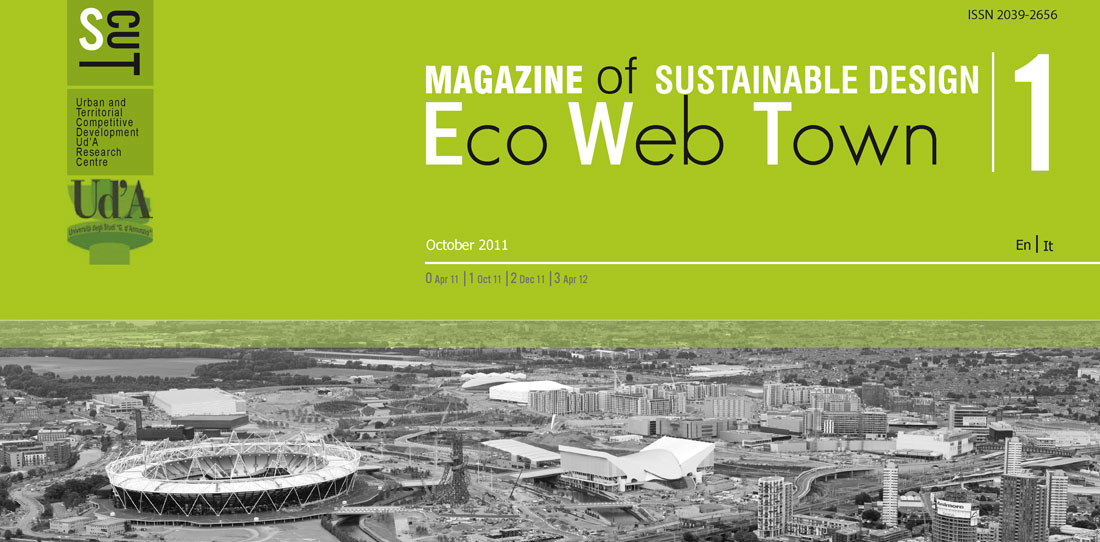

Alberto Clementi |
 |
After our trial issue of number zero, we are starting EcoWebTown with this first issue dedicated primarily to the experiences of London as it prepares for the upcoming Olympic Games. London having explicitly put itself in the running as a candidate to become the “sustainability capital of Europe” is a valid subject within the programme of this review, which intends to actively contribute to spreading the culture for Sustainability Sensitive urban projects, considering it a necessary prospective for the urban planning and architecture of our times. In this perspective, the far-reaching forecasts for the long term plans for the city of the Games, and in particular the programmed disposal and reuse of the phases of the Olympic works, appears to offer an important lesson, within which we can find significant solutions favouring new sustainability in urban planning.
Together with these reflections on the experiences of London, the review inaugurates a work of critical excavation on positions which are influential on the thought behind projects for sustainable city projects, probing the meaningfulness and the utility itself when confronting contemporary challenges.
Particularly illuminating in this sense is the contribution of Felix Guattari, brought back by Andrea Cavalletti using the happy expedient of an impossible interview. The interview, built from a selection and adaptation of extracts from the works of the great French philosopher, warns us not to try and squeeze the idea of ecology into that of environmental ecology, observing that in particular this latter often cohabits ambiguously with regressive ideologies, as seen under cruel dictatorships, and is at any rate idyllic as regards nature. He comes down as decisively in favour of a wider definition of ecology. The interview invites us to consider contextually the bio-political dimension , -social and existential-, to be entwined with that which is environmental, in search of renewed relationships between environmental rationality, social changes and new forms of organisation of individual subjectivity.
From this point of view, Guattari’s intuitions introduce a direction in research – radically different but in line with, in its conclusions, the theorizing inaugurated by Bateson of ecology as a science of the relations among variable complexes (G. Bateson, Steps to an Ecology of Mind, 1972) – which seem perfectly in tune with the need to formulate a more complex concept of sustainability, including in particular those dimensions which are equally relevant when formulating social, economic and mental policy. Something like this has at any rate already occurred partially on a European level, where in official documents sustainability has taken on a role of mediation between environmental, social and economic questions attributing to projects the responsibility of reconciling all the several issues.
...read more
“Planning a sustainable city. A critical anthology”, by Ester Zazzero |
 |
Sustainability. A multi-dimensioned stratified notion
A rapid review of recent debate on urban sustainability shows the importance of accepting the essentially environmental approach of sustainability, which, as we know, adapts the desirable level of life to the burden this will place on available natural resources. Not less important, however, are positions maintaining a different perspective, in particular, one which considers the objectives of social justice and appropriate economic development. This interpretation is acquiring a salience which is as significant as that traditionally given to the environment, and works together with this latter to reach “total sustainability”, more and more often the base of Communitary objectives. The notion of sustainable development thus understood appears much more inclusive than one which is only environmental, as, aside from the need for long term conservation of the environment (to transmit it to future generations), it also takes into consideration quality of life (not depending exclusively on an increasing income), equality among citizens (including the prevention of poverty), intergenerational equity (the inhabitants of the future deserve an environment which is of a quality which is at least equal to today’s) and the social and ethical dimensions of wellbeing.
Perspectives within the discipline
Considering the environmental dimension of sustainability, we should note that conservation of natural resources is not an invention of our times. Though formulated differently it is at the root of modern urban planning and architecture. The rediscovery of natural conditions, used by Le Corbusier at Villa Radieuse, can, in fact, be reread as a way that new architecture should aspire to principles that respect the environment. A project such as Chandigarh testifies pragmatically to the importance attributed (even then) to vegetation, the sun, the climate, to saving local resources, with an approach that still today .....read more
O. Arup - The sustainable city is a circular system…
J. Corner - Landscape as a possible model for cities....
R. Waldheim - Landscape as Urbanism ....
C. Emelianoff - Beyond the ecologic vision......
 |
I am passionate about cities. They are the very drivers of our culture and of our economy. The only sustainable form of development in the modern age is the compact, well connected, well-designed, environmentally responsible, live-work-leisure city, where poor and rich can co-exist side by side and not in ghettos. Cities are first and foremost for the meeting of people – for friends and strangers, and for the exchange of goods and ideas. The concepts of citizenship, civil society and civic responsibility were all born in the city. Interesting things can happen when there is a mix of people and activities in fl exible spaces. Well-designed buildings and public spaces can encourage social inclusion and bring joy to users. If we build well, we can create a socially inclusive environment. A way of measuring the quality of life in cities is by the design of public spaces which can contribute great vitality. Every individual should have the right to well-designed public space – this should be part of a charter of human rights. Everybody should be able to sit on their own door step or a bench close to their home, and they should be able to see a tree from their window. Everyone should be able to find a public square a few minutes from their front door and be able to reach a park easily. The most important rule of successful sustainable urban development is to develop only brownfield land and underused buildings and not to expand onto greenfield sites. ...read more
An Impossible interview with Felix Guattari, by Andrea Cavalletti |
 |
Michel Foucault has described the disciplinary function of spatial apparatus, and shown us how interest in the environment and the concept of environment itself has provided an important key to define bio-political governmentality, and the modern control functions of life. What are your ideas on today's interest in ecology and the urgency of environmental issues? How are we to locate these current, and certainly legitimate, exigencies as regards the control horizon?
I believe that the word “ecology” itself is very ambiguous. Usually, in fact, it becomes a mere synonym for “environmental ecology”, but this equivalence or synonymy is not a given. It is indeed a reduction, or better a territorialization among the dominant schemes. In this sense, reduced to the notion of natural environment, the ecological instance speaks for old reactionary refrains, dangerous biological or territorial myths, their archaic values, and may even - as has happened - cohabit with Nazi practices and ideals. Like his collaborators, the bloodthirsty leader was a lover and protector of nature, a vegetarian, a friend of dogs and such an enemy of vivisection that practitioners were sent to concentration camps. Nazism was in fact a zoo-political project on a grand scale. In several ways, a similar ecology can still today join, and be useful to, the semiotics of subjectivity of integrated World Capitalism, as has happened to the disciplines of Architecture and Urbanism. No one obliges us to use pre-packaged concepts. We need not resign ourselves to the problems already set. We have it in our power to invent both the problems and concepts. Along with Gilles Deleuze, I defined "philosophy" as the capacity to invent concepts. For my part, and for what concerns us now, I have proposed abandoning this so-called ecology, this solely natural environmental ecology, by inventing the concept of “ecosophy”. If in the name of ecology repressive power still speaks within us, if the dominant semiotics of urbanism and architecture are useful to introjections of this power, if they structure the subjectivity set by integrated World Capitalism, ecosophy instead uncovers new problems, it opens perspectives in environmental issues themselves, it reveals different perspectives of subjectification. ...read more
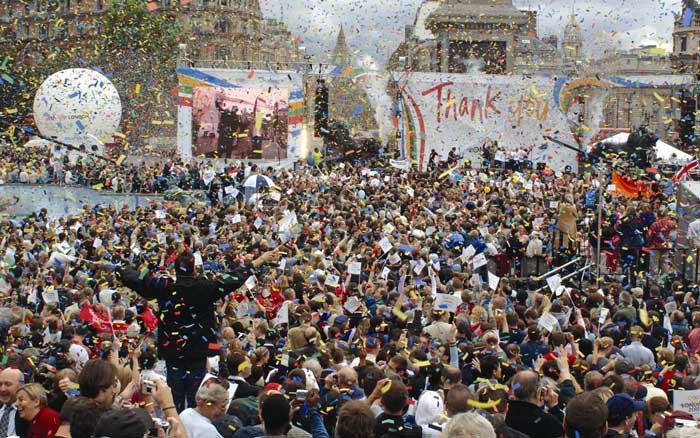
 |
M.A. The Olympic Park project for the 2012 Games was announced as a project-manifesto of sustainability when London bid to host the 2012 Olympic Games and Paralympic Games, the proposal committed not simply to put on the biggest sporting event in the world, but to host the world’s first truly sustainable Olympic and Paralympic Games. How has this progressed and what are the elements which underpin the project's environmental and ethical responsibility, knowing that in the past only a few similar experiences have represented any real opportunity for growth and redevelopment of areas affected.
M.K. Sustainability is generally addressed through technological solutions, the Olympic Park project instead tries to respond to the structural theme of sustainability through a fundamental choice that inspires the whole process of design and construction of the Olympic program. A choice based on a desire to see the whole plan of the Olympic Park as fallout of a more ambitious project, one that plans to redevelop one of the most neglected area of the United Kingdom, the East End, making it an area with a high quality of life, by creating a new urban zone equipped with one of the largest urban parks ever built (220 ha). This objective can be achieved only thanks to the great opportunities offered by the huge economic resources made available by exceptional events like the Olympics Games. Throughout the design process the main goal was urban and environment regeneration, even before selecting it as a suitable site for the Olympic Games. In other words, the design of the Olympic Park will be within the “essence” of the regeneration project of the Lower Lea Valley **, the master plan of which was adapted to the needs of the Games, according to a process completely opposite to what had previously been adopted for all exceptional events (Our vision is to use the power of the Games to inspire lasting change).
According to this philosophy the project’s sustainability is recognizable in the correctness of the goals set for it, that allow one to avoid a wasting of resources that normally occur in the organization of large events.
M.A. Urban and environmental regeneration of East London is therefore a crucial point of the Olympic program. What was the basis for the design choices and what are the phases into which they have been articulated?
M.K. The project is divided into three different master plans: the first one is the master plan of the Olympic Games, the second is the master plan of the so-called phase of Transition ...read more
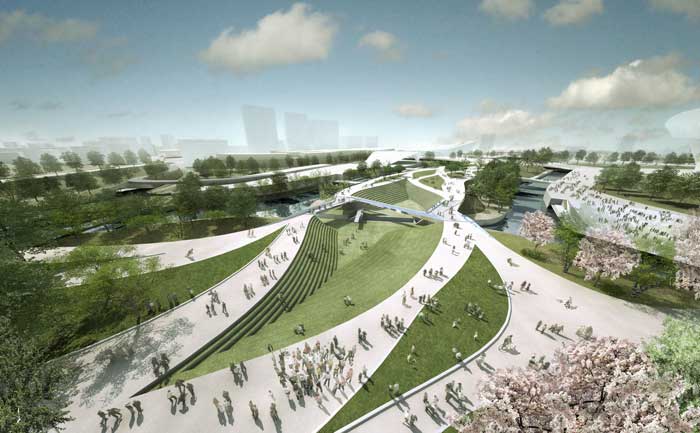
 |
The London Olympic Park project is one of the most ambitious projects set in the United Kingdom for the next twenty five years. Not only as part of the London Olympic Games in 2012, but as a catalyst for the regeneration of East London. The park is located in the Lea Valley River Area in Stratford, East London and comprises the regeneration of a hundred hectares of Brownfield land.
That the park with the Olympic facilities built from 2008 to 2012 for the London 2012 Olympic Games would not only be part of a global event but also form the legacy of the park after the event was clearly part of the vision of the original bid in 2005. In order to set out the key policy priorities to realise this vision sustainably with five key sustainability principles set up at the outset. The Olympic Delivery Authority (ODA) (2007, p.8)1 refers to these principles in its strategy “five ‘headline themes’ as key policy areas, which were: Climate change; Waste; Biodiversity; Healthy living; Inclusion. These represent the priority sustainability themes across the entire London 2012 programme (including venues outside London), and form the basis of strategies and action plans for the delivery bodies and official stakeholders”. These five key sustainability themes have been measured against 12 objective areas to track progress. The master plan for the site is being delivered by the Olympic Delivery Authority with the legacy of the park delivered by a company established for this purpose the Olympic Park Legacy Company (OPLC) which will look after the site for the next 25-30 years....read more
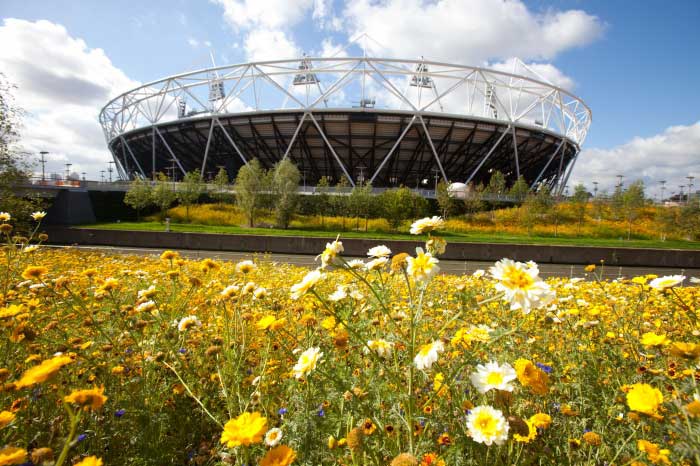
 |
The projects for the upcoming 2012 Olympic Games in London must prove that they are up to the important task which London proclaimed for them when it launched its candidature to organize the Olympics: that of being the first ever sustainable games.
With this as premise, the planners of the sports venues have carried out their tasks each interpreting in his/her own way the theme of ecological sustainability in construction and applying the motto of London 2012 “reduce, reuse, recycle”. All had a common objective, that of conciliating immediate requirements, connected to the two weeks of the event, with the long term requirement, that of the Legacy, when the sporting structures will take on the role of structures on an urban scale. This double modality obliged all the designers to take an unusual approach to their projects, forcing them to think contemporaneously of the performance of the building on the international stage as well as on a local dimension.
The negative examples of Sydney and Athens, both forced to spend enormous amounts to maintain structures which since the end of the games have been little used, spurred the ODA to seek forms and ways to reduce waste, first of all by systematically adopting a philosophy of recycling and of the dimensional adaptation of the venues. Several of the structures of the Olympic Park were conceived using a “reversible design” approach, works which at the end of the games can be totally or partially dismantled. The Basketball Arena, designed by Wilkinson Eyre Architects and KSS Design Group is the best example. In fact this complex was conceived so that it can be completely dismantled and recycled in other structures in the UK. So this important aspect was kept in mind right from the beginning of both the planning process and the construction phase, with the assembly of the elements of the structure in steel making them easier to take apart and remount in another place. The 12,000 seats, for example, will be reused at the Silverstone racetrack and in other sports structures, while the external structures will be sent to the 2016 Games in Rio de Janeiro.....read more
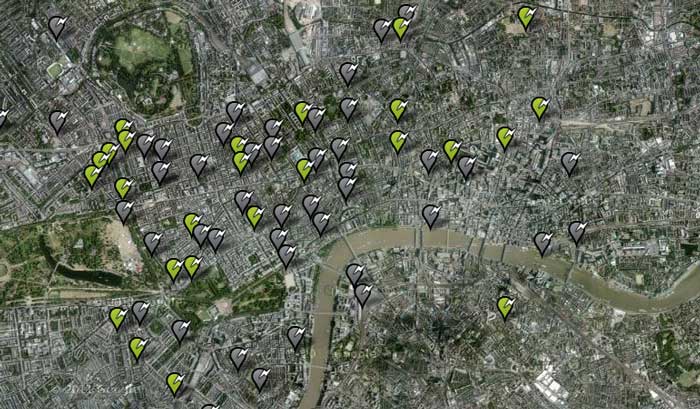
 |
One of the great transformations which have changed London in recent years, as part of the Olympic programme is an ambitious programme launched by the Mayor of the city, Boris Johnson, always sensitive to transport sector issues, to make his city, a city of electric cars. It follows up on the programme Turning London Electric, promoted by London’s administration in 2009. Animated by a desire to reduce CO2 emissions by 2020, the programme Source London has started officially and will allow London to become the first “green capital” with 1,300 charge points for electric cars by the end of 2013.
According to the ambitious programme launched by the administration, the city must quickly revolutionize travel patterns in private transportation while at the same time stimulating the market for electric vehicles. The new electrical charge points would become a metropolitan network of eco-chargers. When complete the number of charge points will exceed the present number of petrol stations. As far as costs go, and consequently the savings promised by the programme, the owners of electric cars can charge their vehicles an unlimited number of times each year purchasing a card which would cost about 120 euro. Estimates of the reduction in CO2 emissions have been 40%. But the savings for those London drivers who sign up for Source London could be even more significant. Each would save an estimated £3,500 per year, thanks to the extension of the traffic tax on access to the centre (the London congestion charge) and of the road tax and this apart from the savings on the cost of fuel and maintenance of their vehicles.
It is estimated that there are about 2,100 electric vehicles in London today and almost 400 charge points which, according to the plan, should allow every Londoner to find a charge point at not more than half a kilometre from his or her home or workplace. ....read more
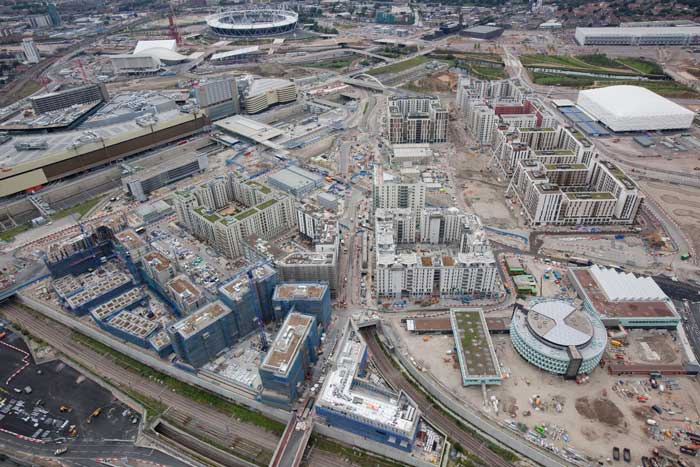
 |
Alongside the International media re-launch of London and the planning and control on quality building for environmental sustainability, the 2012 London Olympic Games programme intends to offer housing for Londoners in the lower wage bracket, paying particular attention to the global sustainability of the interventions. This policy risks going into crisis following the failure of some building development projects defined in the Olympic masterplan. The biggest risk is connected to the chain effect started by the current economic crisis. In fact the total development plan includes both a very high quota of residential housing situated outside the Olympic village: a social economic re-launch, but also construction in a target area, characterised by negative parameters and long term criticism.
The idea is to transform this urban area in decline, that of Stratford, east of London, into a new propulsive centre for the urban area and the city; a hypothesis which is not new but the fruit of a long planning and programming process, which has found its catalyzing moment in the big event, collectively seen today as a symbol of the revival of a European capital city. The attention to social inclusion is shown by the involvement of the lower wage bracket population through the action of private and mixed structures which according to the English tradition contribute to the creation of social residential housing.
The project is situated in a vaster development plan within a strategic framework of regeneration, built on a few key themes to be carried out through social policies, centred on local authorities and redefining the economic profile of the area. The intention is to insert a portion of territory into the more complex urban development, through an attractive functional mix of quality housing, green areas, new connections and areas which are highly suitable for living. ....read more
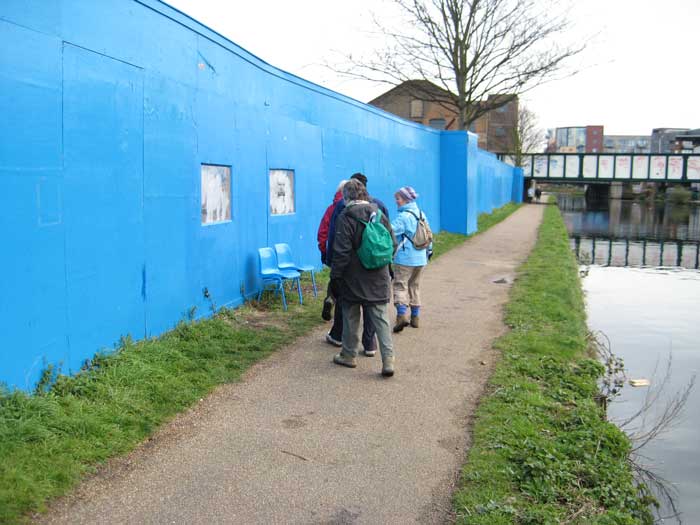
 |
We have come to accept that an area chosen to be the scene of a new urban development project is defined as an “urban void”, but the East End of London, which is destined to contain the Olympic Village of 2012, and above all its community, especially the most lively and creative part of it, does not intend to remain passive as regards decisions that will determine the future orientation of the area. In an article that appeared in The Guardian (1), Rushanara Ali describes how the 2012 Olympics were greeted enthusiastically by Londoners in general and, in particular, by the inhabitants of the area which foresaw in the event new development opportunities and jobs for the young, manna from heaven in a period of recession caused by the planned cuts of Prime Minister David Cameron to reduce public spending. Ms. Ali describes the carelessness of the Commission which was named to manage the event, the Locog (2), that heralded the Games as a moment of social inclusion, promising 6,000 jobs for the residents of the Tower Hamlets and Hackney neighbourhoods. In the end the opportunities turned out to be more limited and the number of jobs reduced to a meager 334. For some tenders even the procedure which had been planned initially was changed, with negative consequences for local entrepreneurs who had willingly invested to offer their services to the people of the Olympics. Facing this reality the local community has mobilized, to pluck their situation from limbo and from the centralizing vision which is inattentive to the needs of the neighbourhoods, to defend their existence and avoid the complete removal of the identifying characteristics of the area. ....read more
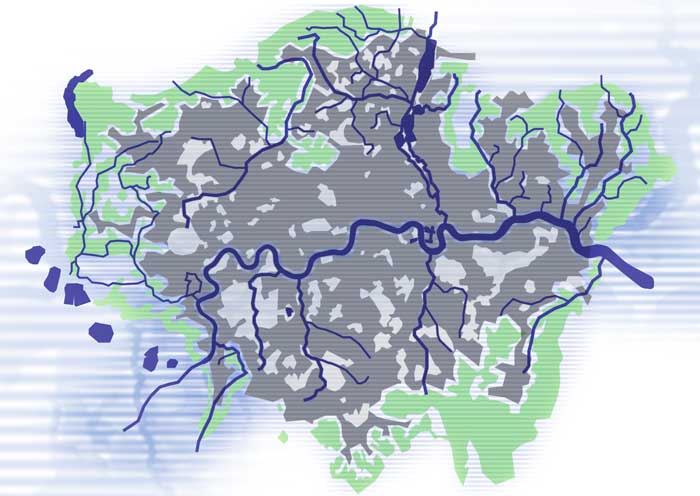
 |
THE BLUE RIBBON NETWORK
The visionary idea of the local administration to make London the sustainability capital of the world has been expressed since 2004 with the London Plan, a city strategy composed of seven primary policies: four theme based and three transversal. Blue Ribbon Network (BRN) is the name given to the strategic plan granted by the basin and the ideographic grid of the Thames, for its resemblance to a network of blue ribbons crossing the land: the strategy of sustainable development linked to the BRN is one of three transversal policies covered in the London Plan. The other two are: zoning and planning strategies, in order to make London a compact city, and strategies for the improvement of urban metabolism and adaptation to climate change. The Blue Ribbon Network is a complex river system which consists of canals, tributaries, reservoirs for drinking water, ports, docks, lakes, tributaries, streams, rivers, even if channeled, covered or deviated. This minor network of water was until recently considered to be a load bearing structure, morphologic and functional for the sustainable urban development of the metropolitan system. The opportunity offered by the BRN is to create a network of urban water spaces that can offer a sequence of active and attractive sites, public spaces which are useful environmentally and socially. ....read more
|
The certification of environmental sustainability, from building to neighborhood projects, by Edoardo Zanchini |
 |
In the coming years it will be important to pay attention to sustainability certification, not only for the increasing importance that it is assuming, especially in construction and energy, but because of a progressive enlargement of interest in interventions that go beyond single buildings. Moreover, the number of cities and urban transformations that propose themselves as the new frontier of sustainability are constantly increasing. The list could be long and now concerns interventions that are not confined to Northern Europe (Freiburg, Malmoe, Stockholm) because one can find examples in the United Arab Emirates (Masdar city) as well as in China (Dezhou), and each experience offers a particular idea of neighbourhood sustainability. The most interesting field of application for research on the question of sustainable design is in cities. It aims at understanding how to respond to increasingly complex problems related to environmental management, supply and consumption of resources, pollution and soil consumption. For this reason it is important to study the ways in which the most interesting and widely used certification systems evaluate sustainability when it is not limited to the construction of single new buildings, but concerns integrated interventions and a wider environmental context.
The first reference to study is the LEED brand (which stands for The Leadership in Energy and Environmental Design), the best known system of classification and certification of sustainability for buildings at an international level. A first draft was proposed in the United States in 1998 by the U.S. Green Building Council (USGBC). The success of LEED, with more than 14.000 certified buildings and its application in more than 30 countries (the Italian branch opened in 2010), is increasing and so far has been applied especially on commercial buildings, offices and public buildings. The system uses scores and thematic categories, updated periodically, making it possible to apply it to any type of building and, in 2009, it widened its focus beyond single buildings by establishing a specific certification system called LEED for neighborhood development. An environmental organization,....read more